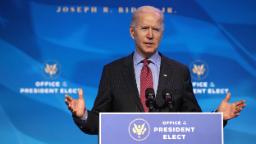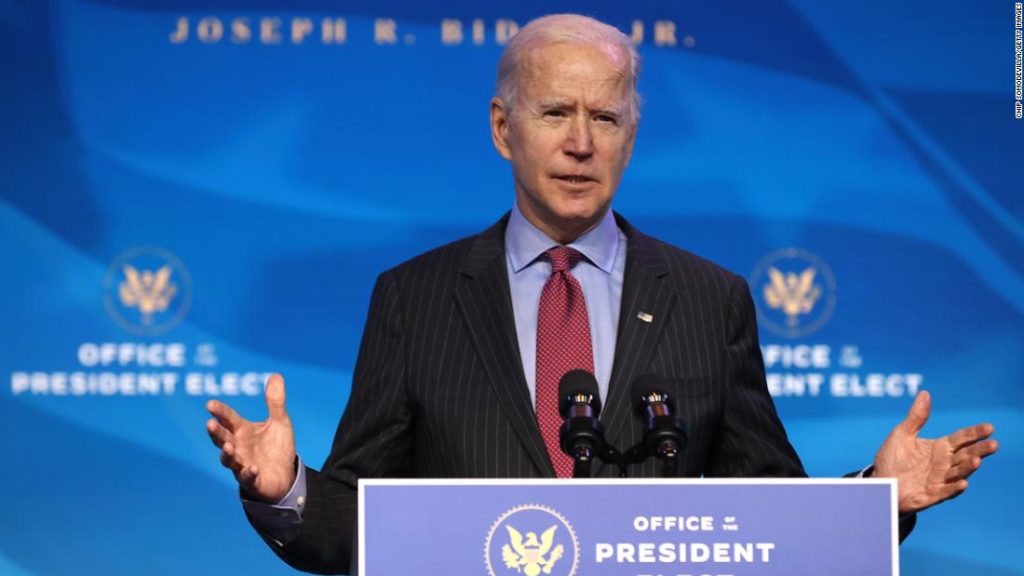
Now that Democrats control both chambers and the White House, Biden is pushing for the big steps he says are needed to address immediate needs and control the coronavirus pandemic. He also plans to lay out an economic recovery plan in coming weeks that aims to create jobs and combat the climate crisis, among other measures.
Beefed-up stimulus payments
The new payments would go to adult dependents that were left out of the earlier rounds, like some children over the age of 17. It would also include households with mixed immigration status, after the first round of $1,200 checks left out the spouses of undocumented immigrants who do not have Social Security Numbers.
Enhanced unemployment aid
He would also extend the payments, along with two key pandemic unemployment programs, through September. This applies to those in the Pandemic Emergency Unemployment Compensation program who have exhausted their regular state jobless payments and in the Pandemic Unemployment Assistance program, which provides benefits to the self-employed, independent contractors, gig workers and certain people affected by the pandemic.
Lawmakers only provided an additional 11 weeks of support in the December package, which will last until March.
Rental assistance and eviction moratorium
The plan would provide $25 billion in rental assistance for low- and moderate-income households who have lost jobs during the pandemic. That’s in addition to the $25 billion lawmakers provided in December.
The plan would extend the federal eviction moratorium, set to expire at the end of January, to September 30, as well as allow people with federally-guaranteed mortgages to apply for forbearance until September 30.
Help for the hungry
Biden would extend the 15% increase in food stamp benefits through September, instead of having it expire in June. He would invest another $3 billion to help women, infants and children secure food, and give US territories $1 billion in nutrition assistance. And he would partner with restaurants to provide food to needy Americans and jobs to laid-off restaurant workers.
More money for child care and child tax credits
The plan calls on Congress to create a $25 billion emergency fund and add $15 billion to an existing grant program to help child care providers, including family child care homes, to pay for rent, utilities, and payroll, and increased costs associated with the pandemic like personal protective equipment.
It also proposes expanding the child care tax credit for one year so that families will get back as much as half of their spending on child care for children under age 13.
A temporarily increase of tax credits
Biden wants to boost the Child Tax Credit to $3,600 for children under age 6 and $3,000 for those between ages 6 and 17 for a year. The credit would also be made fully refundable.
And he proposes to raise the maximum Earned Income Tax Credit for a year to close to $1,500 for childless adults, increase the income limit for the credit to about $21,000 and expand the age range of eligibility to cover older workers.
Both of these are aimed at supporting low-income families, including millions of essential workers.
Subsidies for health insurance premiums
Biden is also calling on Congress to subsidize through September the premiums of those who lost their work-based health insurance.
He wants to increase and expand the Affordable Care Act’s premium subsidies so that enrollees don’t have to pay more than 8.5% of their income for coverage — which is also one of his campaign promises. (The law is facing a challenge from Republican-led states that is currently before the Supreme Court.)
Also, he wants Congress to provide $4 billion for mental health and substance use disorder services and $20 billion to meet the health care needs of veterans.
Restoration of emergency paid leave
It would extend the benefit to workers employed at businesses with more than 500 employees and less than 50, as well as federal workers who were excluded from the original program.
Under Biden’s proposal, people who are sick or quarantining, or caring for a child whose school is closed, will receive 14 weeks of paid leave. The government will reimburse employers with fewer than 500 workers for the full cost of providing the leave.
More assistance for small businesses
It also proposes making a $35 billion investment in some state, local, tribal, and non-profit financing programs that make low-interest loans and provide venture capital to entrepreneurs.
Aid for states and schools
Biden wants to send $350 billion to state, local and territorial governments to keep their frontline workers employed, distribute the vaccine, increase testing, reopen schools and maintain vital services.
Additional assistance to states has been among the most controversial elements of the congressional rescue packages, with Democrats looking to add to the $150 billion in the March legislation and Republicans resisting such efforts. The December package ultimately dropped an initial call to include $160 billion.
Biden’s plan would also give $20 billion to the hardest-hit public transit agencies to help avert layoffs and the cutting of routes.
The plan would provide an additional $170 billion to K-12 schools, colleges and universities to help them reopen and operate safely or to facilitate remote learning.
Congress approved $82 billion in aid for schools in December.
Increased support for vaccines and testing:
The proposal would also invest $50 billion in testing, providing funds to purchase rapid tests, expand lab capacity and help schools implement regular testing to support reopening.
It would also fund the hiring of 100,000 public health workers, nearly tripling the community health workforce. It would address health disparities by expanding community health centers and health services on tribal lands. And it would provide support to long-term care facilities experiencing outbreaks and to prisons for mitigation strategies.
A $15 hourly minimum wage:
Biden is calling on Congress to raise the minimum wage to $15 an hour, and to end the tipped minimum wage and the sub-minimum wage for people with disabilities.
This story has been updated with additional details.
CNN Business’ Anna Bahney contributed to this report.
You may also like
-
UK coronavirus variant has been reported in 86 countries, WHO says
-
NASA technology can help save whale sharks says Australian marine biologist and ECOCEAN founder, Brad Norman
-
California Twentynine Palms: Explosives are missing from the nation’s largest Marine Corps base and an investigation is underway
-
Trump unhappy with his impeachment attorney’s performance, sources say
-
Lunar New Year 2021: Ushering in the Year of the Ox

